A sensational October
Tuesday, November 3, 2015
Highlight of the month is, as you would expect, autumn
colour - full in your face colour all over the gardens
Always a strong contender for the title of most
colourful shrub is euonymus alatus. It often keeps this colour
until December, frosts and gales permitting
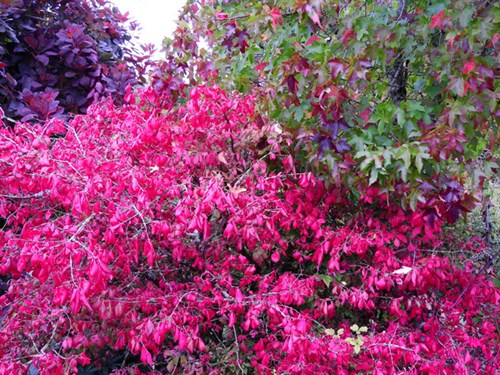
What an unforgettable month. All the frustrations of a
disappointing summer blown away in an extravagansa of colour. Fine
weather to be outdoors and carry out essential autunmn jobs and
complete them . All the winter firewood sawn up and stacked away, a
nice change from 9 months of non stop gardening.
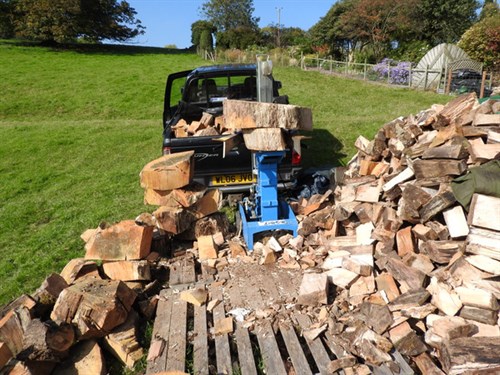
And talking of outrageous colour what do you think of
this close up of a well known, tall border perennial. Any ideas
what it is? Answer at the end
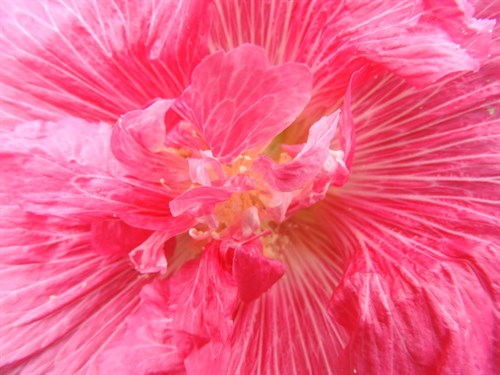
Weather
Scarcely any rain in first 3 weeks of the month when West Wales
was in the headlines for having the lowest recorded rainfall in the
UK, Milford Haven recording just 1 mm of rain in the period. Sunny
days and cold nights was the pattern. So close to an air frost on
numerous occasions but with a nightime regime of covering with
fleece most tender plants especially those in active growth, there
was no damage anywhere. Worth all the effort to prolong the last
days of the growing season. Early outlook for November indicates
continuing warmer weather with no frosts - we are bound to pay
later but enjoy it while we can as it certainly makes the winter
seem shorter. Lowest temperature 0C on 25th with 13 other days
below 5C. Warmest 18C on 5th and 6th and 16 other days above
15C
Garden Update
Vegetables continued to crop well throughout the month and there
were more ready for harvest than at any time this year. By luck,
planting for succession and the choice of suitable cultivars we had
sweetcorn and runner beans throughout the month. Sweetcorn
continues with 25 plants of maturing cobs still to come from a
sowing made on 26 June, variety "Swift". I am always quite sad
however when the runner beans come to an end as they are a reliable
staple for the kitchen being available every day since late July
and a good accompaniement to any meal. We never freeze them so we
and our neighbours enjoy them fresh.
Looking rather tired now but still tender and tasty from
a July sowing. Variety "White Lady"
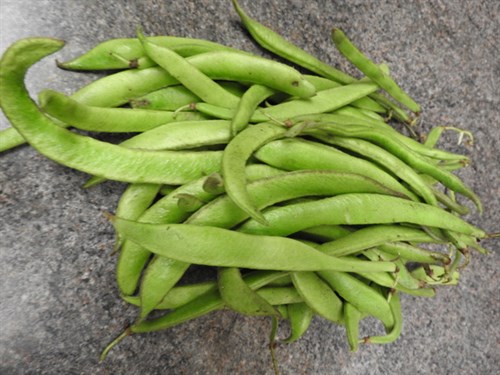
Their winter eqiuivalent is the Brussels sprout which should
provide regular pickings into the New Year and already tasting good
even withorut a frost. There are a whole range of other brassicas
to enjoy particularly some fine cauliflowers and the cut and come
again benefits of dwarf kale, the new super food and ready in just
a minute from steaming.
I continue to mow the lawns about twice a week partly as the
grass is continuing to grow well, having been fed with a high
potash/phosphate winter fertiliser, with adden iron and magnesium
which makes them green up well. Another feed weather permitting
towards the end of the year, should see the lawns through to next
Spring
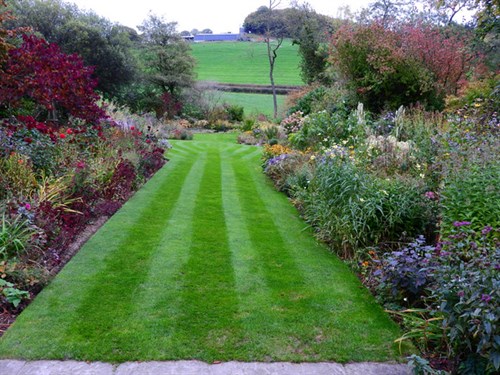
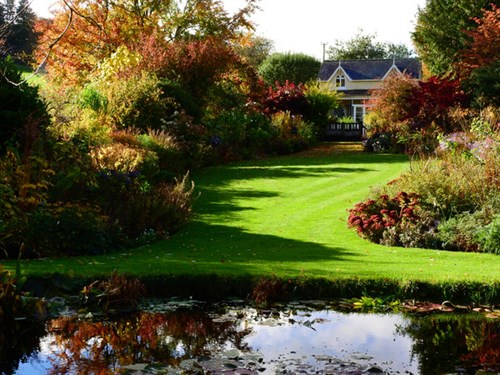
As you may know, contrary to normal recommended practice I cut
back very little in the flower borders until February, giving more
time to dedicate to other essential autumn tasks, to provide food
and shelter for wildlife, enhanced protection for plants in a cold
winter and continuing interest in the borders when hoar frosts
alight on the faded seedheads.
Lovely hues enriched by late afternoon sunshine on
miscanthus seedheads
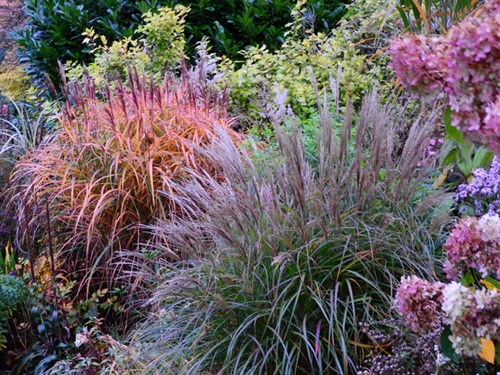
I always however use the opportunity while most plants are still
in active growth to mark with a cane and label, plants for
division, replacement or a fundamental re appraisal of the impact
and structure of the borders.
Seed gathering from the gardens is regular feature in late
summer and autumn, for my own use, to donate to The Hardy Plant
Society for the annual Seed Exchange Scheme (a major benefit of
Membership) and for raffle prizes to the Clubs and Societies I talk
to during the winter and spring. I cannot recommend too highly
joining the HPS a highly regarded organisation within
horticulture and for more information go to www.hardy-plant.org.uk

Everything is now ready for the winter in the nursery with most
plants that need protection put away under cover of frames and
polytunnels, the fires tested, and new horti fleece purcahsed which
is necessary on very cold nights to augment protection in covered
areas.
What's looking good?
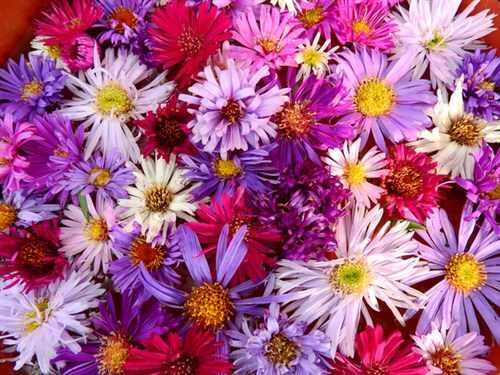
Asters were tremendous, later than usual, but when they
did come, they made up for lost time with a vengance. The heavy
rain in the last week has slowed them down but a few of the 60 plus
we have here continue to thrive, especially the lateriflorus group,
a few others like a.turbinellus, a. pyrenacia laetitia and can you
believe it, a.frikartii "Monch" which has flowered non-stop since
early July. If you grow only one aster, this is the one I would
recommend. Just a note on nomenclature. There has been a name
change for some of the American asters like New England (nova
angliaea) and New York (nova belgii) which now take on the
name of symphyotrichum!. Probably best for us amateurs like me to
continue to call this group "Michaelmas Daisies" which they have
been called for generations
Another favourite aster of mine is nova belgii type
"Marie Ballard" as near to blue as I have found in the genus
with long lasting double flowers that don't fully open to reveal
their yellow stamens until very late on
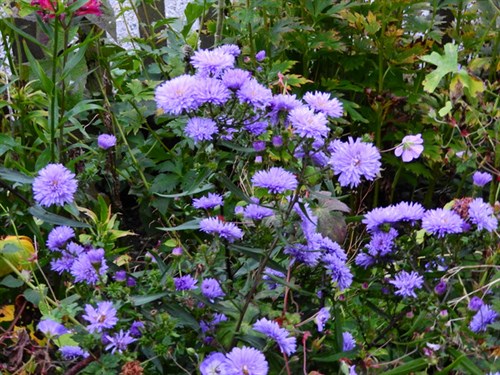
Continuing my "blue heaven" theme, Salvias have revelled
in the bright sunshine, the lack of rain and the shortening
day length which is natural to those coming from central America.
They have gone into overdrive!! I continue to take cuttings and
when the frosts do come will dig up some of the biggest and best
specimens to overwinter and take more cuttings next Spring, after
first cutting them back hard.
5' tall is salvia patens "Guanajuato"
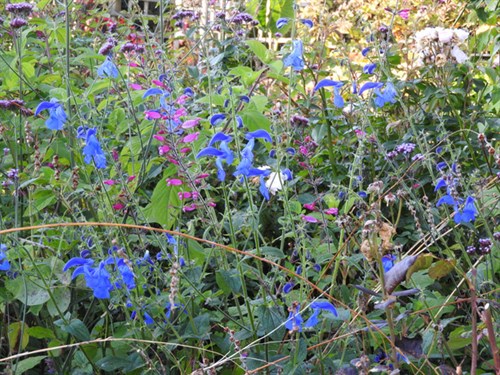
Another 5 footer is S. "Phyllis Fancy" set against the
silver foliage of an unknown artemesia
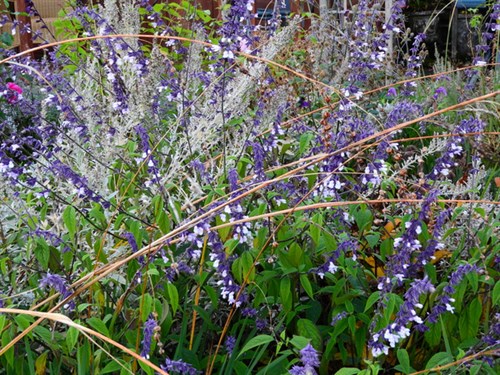
And seen everywhere it seems these days is s. "Amistad"
said to be hardy once established in well drained soil
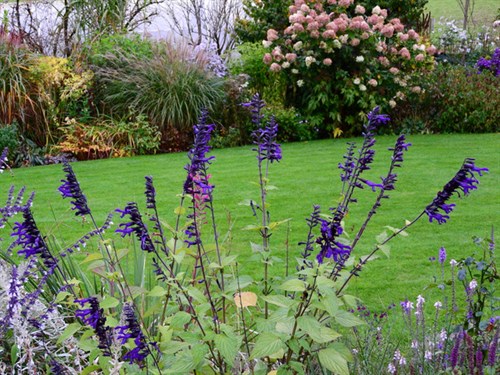
Tree and shrub colour has never been better as they continue to
mature and the perfect weather conditions of sunny mild days and
cold niights work their magic to ensure the best autumn colour. I
still wish that when starting the gardens many years ago I had
planted more trees and shrubs, but it is too late now. Those we do
have were well chosen I think and give us great pleasure.
Of all the 80+ hydrangeas we have here the most
intriguing is h. "Preziosa" which changes flower and leaf colour
throughout the growing season coming to its peak in October when
the flowers are a rich purple red and the leaves have become almost
black
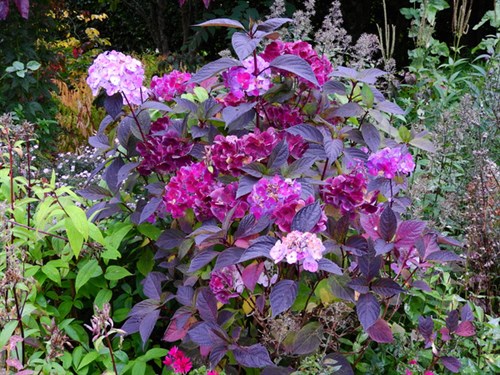
This choice shrub/small tree is cercis canadensis
"Forest Pansy" and my favourite red dahlia "Summer Night" in the
Red Border, a misty late afternoon adding to the atmosphere of the
scene
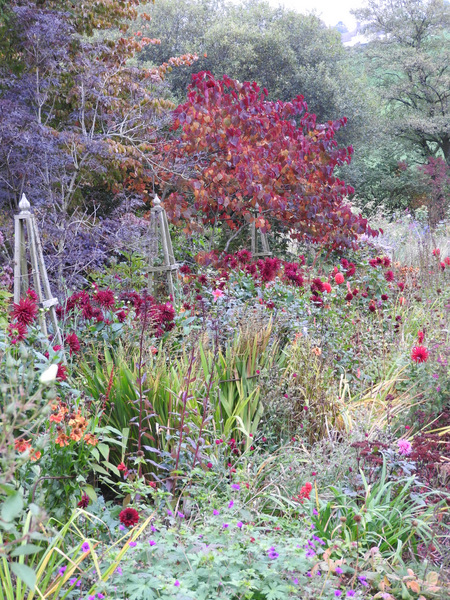
Opposite the Red Border are the contrasting tones of the
Blue and Yellow border
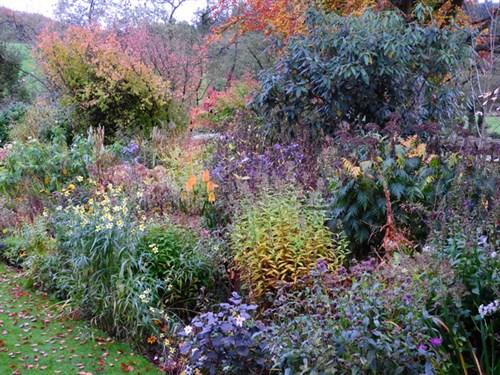
A native wild cherry on the garden boundary
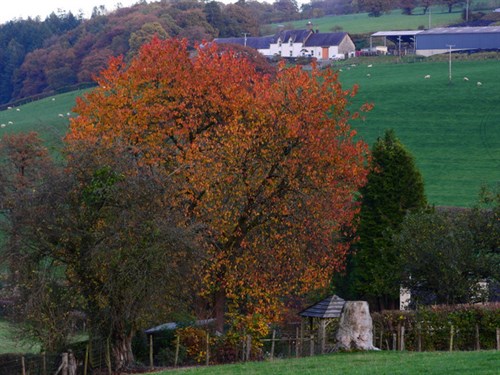
There are many other stars as showcased in the following pics.
It all goes to show how much interest you can have in the garden at
this time of year if you plan carefully.
Aconitum carmichaelii and helianthus "Lemon Queen"
is always a winning combination in the "Picket Border" at the
front of the Lodge with a misty pink symphiotrichum "Star of
Chesters" pulling the two together.
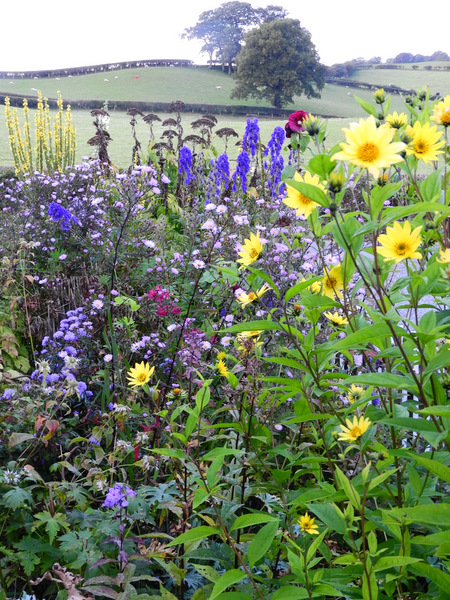
In one of the polytunnels is a large late flower on
hosta plantaginea, a wild form with scented flowers to 2" long.
More reliably flowering under cover as it needs more warmth than
most to bring it into flower
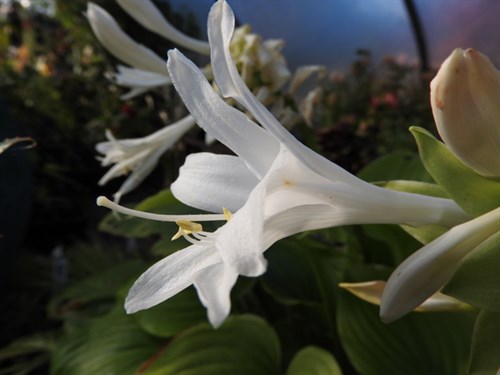
A small selection of some of the later
dahlias
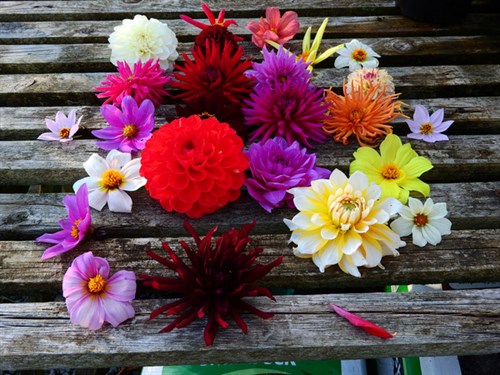
Making quite a statement is the late flowering kniphofia
"Rooperi" at 6' tall with the lovely seedheads of bupleurum
fruticosum in the foreground
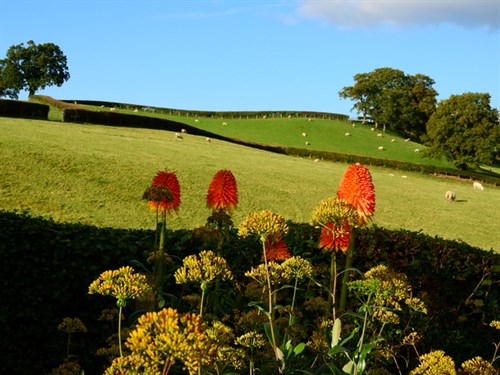
Colchicum "Album" a dainty long flowering form in part
shade with geranium wallichianum providing some gentle natural
support
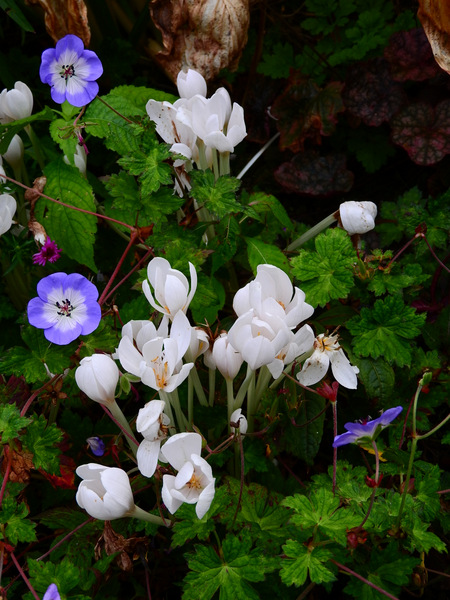
The last picking of sweet peas on 23 October, the latest
we have ever had them
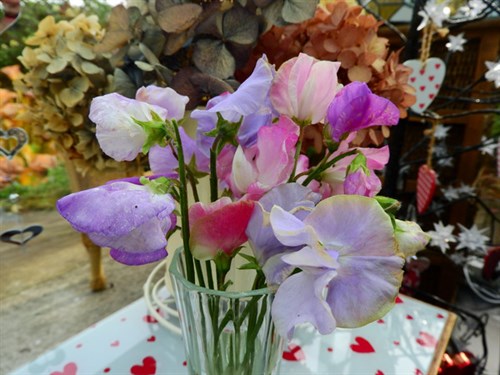
More Blue! Tremendous flowering of Clematis
viticella "Blue Belle"
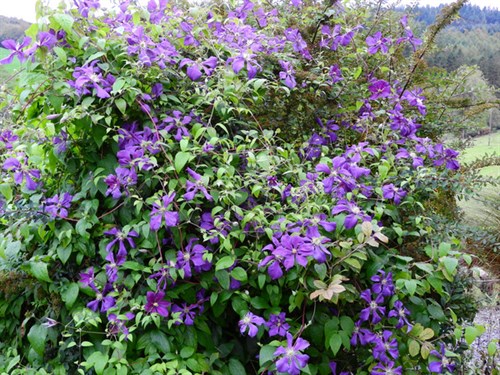
Tender nerines stay in the tunnels year round and this
year nerine sarniensis has flowered better than ever
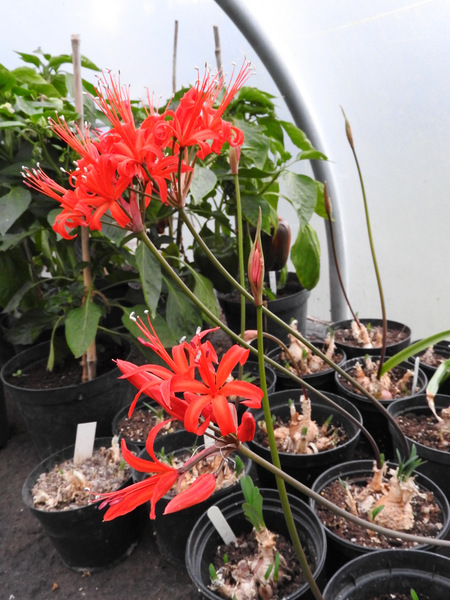
And a recent addition to my collection of impatiens is
the tender i, auricoma taking me to a total of 15 hardy and tender
forms
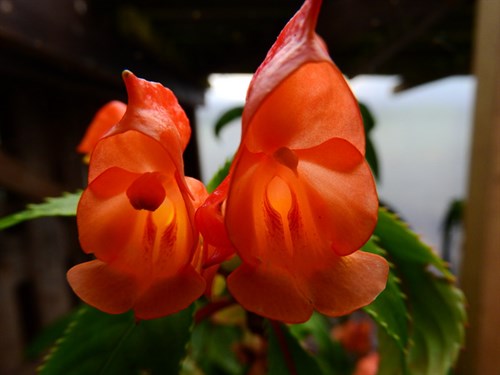
Wildlfe and countryside
Tree colour on our native trees has been sensational highlighted
by the many sunny days we have enjoyed.
Totally natural native oak woodland just beginning to
colour up
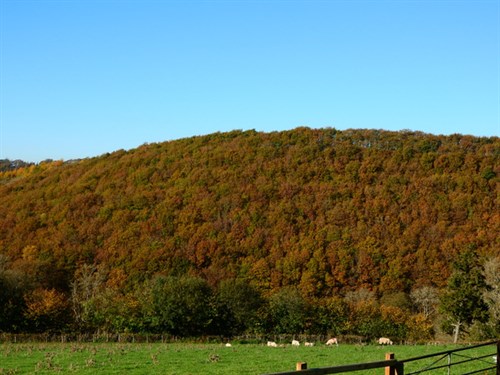
The view to the north east of the Lodge with the setting
sun reflected on the larch. More news next month about the larch
plantations hereabouts and the dreaded phytophthora
disease
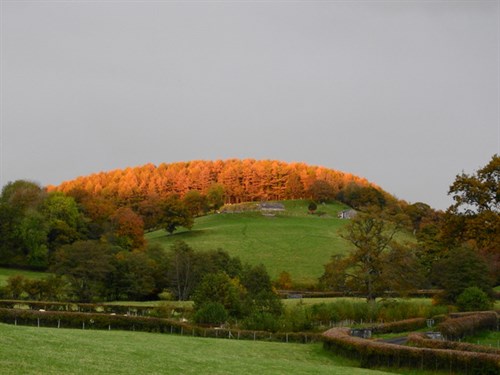
That sunshine has brought out a few butterflies but they had a
poor year here. It was however a surprise to see dragonflies on the
wing the last siighting being on the 31st
An incredibly lucky picture (this time I did have my
camera!!) - a large dragonfly resting on a seed head of clematis
tangutica "Lambton Park" - the first punk dragonfly ever
recorded!!
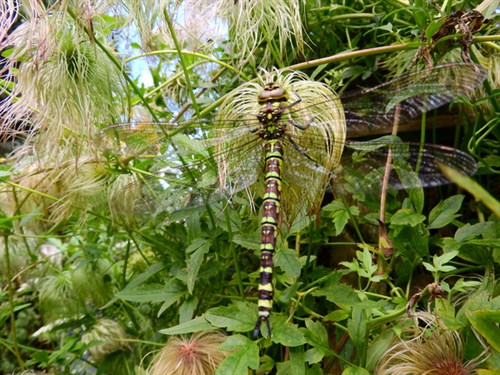
And on 31st of the month a small red dragonfly sunning
itself on a stone
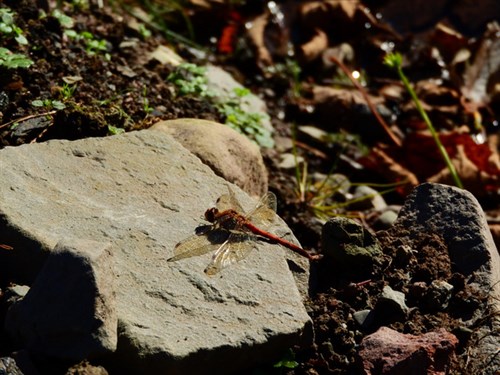
An unusual visitor to the large polytunnel was a black mink in
broad daylight, oblivious to my presence just a few feet away
(without camera of course!). Some years agao they were very common
causing havoc to fish stocks in the ponds and predating almost any
other wildlife they could sink-their teeth and sharp claws into.
Trapping them brought me up close and personal with them and
gradually their numbers reduced. It is also said that if otter
numbers increase, as they have done here over the last 10 years or
so, the mink give way to the larger predator.
Another predator that made an appearnce this month was a
sparrowhawk zipping over the hedgerows to the consternation of many
smaller birds. Jays too have made their annual pilgrimage to the
garden to feast on the continuing good crop of sweetcorn; they have
also in the past devastated pea crops.
The wrecked shell of a cob after the jays had
visited
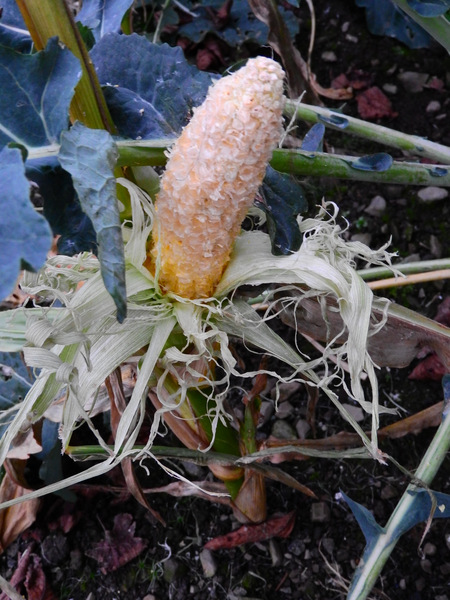
Hedgehogs have also been regularly sighted in and
around the gardens, very welcome visitors given how their numbers
have plumetted.
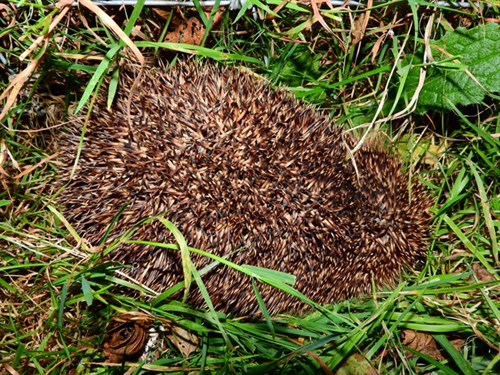
Whilst collecting logs for splitting I turned up
numerous frogs such as this fine fellow well camoflaged in the
leaves
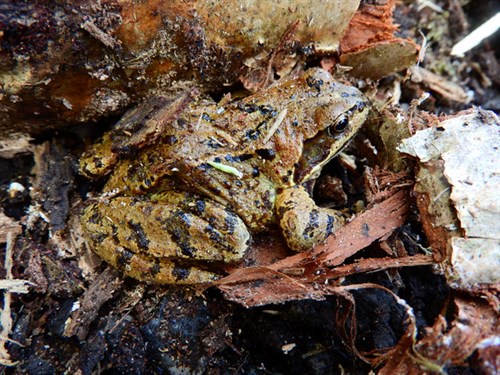
And then a toad almost black against its
background
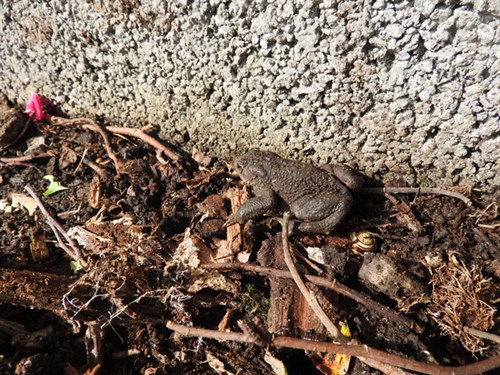
Cobwebs are more prominent at this time of year
highlighted by the heavy morning dews. Usually they are delicate
and lacy but on this morning in the hedgerows they looked more like
a substantial fabric of great pesence, complexity and
beauty
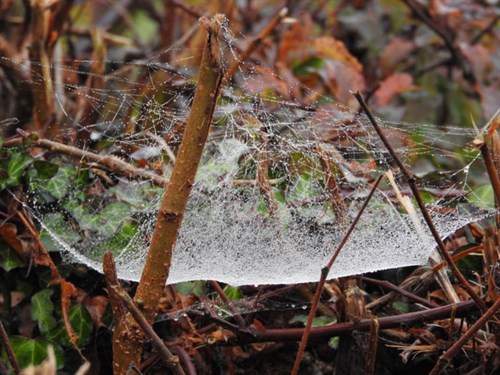
Visits
Although the garden is usually closed in October we hosted a
visit from representatives of several gardening clubs in
Pembrokeshire to discuss their collective booking for next July.
The gardens looked exceptionally good creating a favourable
impression. We already have a number of bookings next July so if
you wou are intending to visit us in 2016 please get in touch soon
to ensure you get your preferred date.
The next 5 pics are all of Hergest Croft on a lovely
autumn day. Make a note in your diary to go next year and visit the
website at www.hergest.co.uk
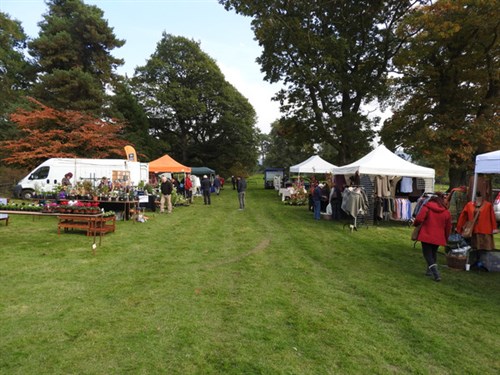
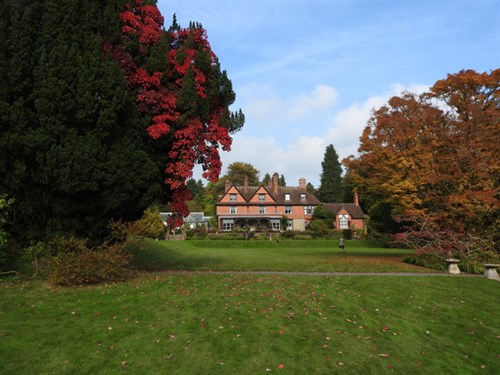
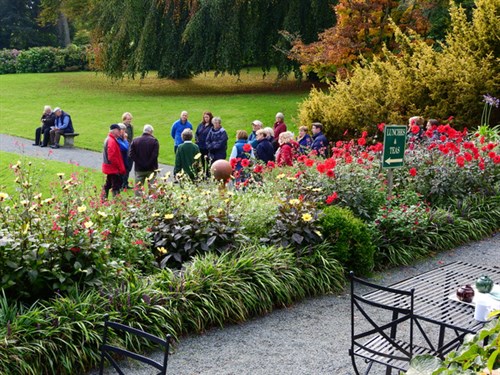 On the
On the
Large drifts of this beautiful colchicum can be
found in grassy areas near the arboretum but it cannot be named
with certainty as no records exist. It is believed to have been
planted in the early part of the last century.
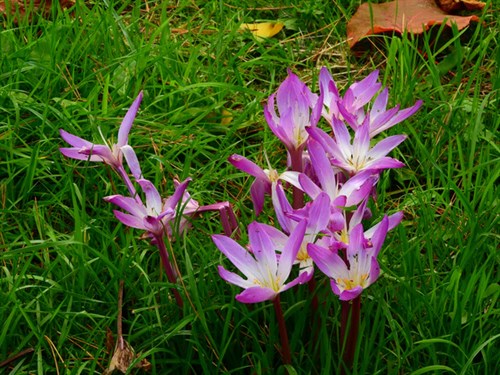
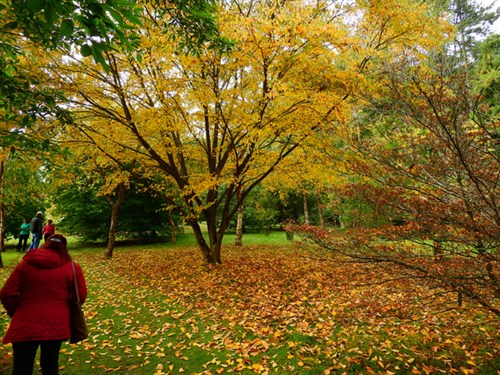
On the road we gave 3 talks to clubs in Penllergaer Swansea, The
Hardy Plant Society in Coychurch and our local club in
Llangadog. There was an exceptional attendance at each meeting
which iis inspiriring for the speaker. Thank you all very much
The talk about to begin at the HPS

Good gardening friends at Llangadog Gardening Club's
meeting and at the back the fabulous buffet they always serve
at the end. They don't come for my talk - it's the food that does
it!!

And finally the answer to the question I posed at the
beginning of this article. The pink flower is from an anemone
centred hollyhock. a gift from Jan. a gardening friend from
Kidwelly. Thanks Jan!!